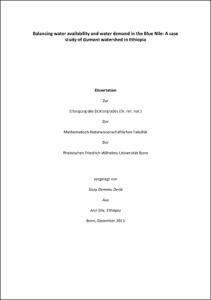Balancing water availability and water demand in the Blue NileA case study of Gumara watershed in Ethiopia

Balancing water availability and water demand in the Blue Nile
A case study of Gumara watershed in Ethiopia

| dc.contributor.advisor | Diekkrüger, Bernd | |
| dc.contributor.author | Derib, Sisay Demeku | |
| dc.date.accessioned | 2020-04-19T21:01:22Z | |
| dc.date.available | 2020-04-19T21:01:22Z | |
| dc.date.issued | 16.04.2014 | |
| dc.identifier.uri | https://hdl.handle.net/20.500.11811/6070 | |
| dc.description.abstract | Ethiopia suffers from economic water scarcity that makes its water utilization difficult. In-depth understanding of the hydrological processes is important for balancing availability and demand. As part of this basin-wide and national concern, this study examines the water balance and water availability on farm and watershed scales in different scenarios. The objectives of the study were (1) to evaluate water use and water productivity of a small-scale irrigation scheme, (2) to evaluate methods for filling gaps in climatic data, (3) to adopt the Soil and Water Assessment Tool (SWAT) hydrological model for modeling hydrological processes using different modeling setups, and (4) to simulate water demand and water stress status for a period up to 2050 using different land-use and demographic scenarios. The Gumara watershed (1520 km2), a tributary of Lake Tana and source of the Blue Nile in Ethiopia, was selected for this study. A case study at a small-scale irrigation scheme shows that there was high water loss during water conveyance and application. At the same time, water stress was observed during irrigation at the scheme level, as the applied water did not match the water needs of different crops. Environmental modeling requires complete climate data sets, which are rarely available. Therefore, different gap-filling methods were applied and tested. Considering data from neighboring climate stations, the methods arithmetic mean and coefficient of correlation weighting methods gave better daily rainfall estimation than the normal ratio and inverse distance weighting methods. Multiple linear regression methods performed well when filling daily air temperature gaps using data from neighboring stations. After seasonal categorization of daily data and optimization of parameters, procedures using maximum and minimum temperature for simulating solar radiation and relative humidity gave promising performances. For process analysis, SWAT was applied for the watershed with an acceptable performance when simulating river flow. The effect of data availability on model performance was analyzed using different numbers of climate stations. Using four and six stations resulted in better SWAT water flow modeling performance as compared to two stations. Penman-Monteith and Hargreaves procedures for potential evaporation calculation resulted in comparable river flow modeling in SWAT. Therefore, the Hargreaves method that needs only air temperature can be used for modeling when other climatic data are not available. Selected watershed management practices shift surface runoff to sub-surface and groundwater flows. An irrigation project planned in the watershed and the watershed management practices shift surface discharge to base flow and evapotranspiration. It will be hard to satisfy the basic human water requirements in 2050 if the existing water management and water productivity conditions pertain. Better green water management and non-consumptive water use options (e.g. hydro power, fishery) can minimize the blue water stress at the Nile basin level. | en |
| dc.language.iso | eng | |
| dc.rights | In Copyright | |
| dc.rights.uri | http://rightsstatements.org/vocab/InC/1.0/ | |
| dc.subject.ddc | 910 Geografie, Reisen | |
| dc.title | Balancing water availability and water demand in the Blue Nile | |
| dc.title.alternative | A case study of Gumara watershed in Ethiopia | |
| dc.type | Dissertation oder Habilitation | |
| dc.publisher.name | Universitäts- und Landesbibliothek Bonn | |
| dc.publisher.location | Bonn | |
| dc.rights.accessRights | openAccess | |
| dc.identifier.urn | https://nbn-resolving.org/urn:nbn:de:hbz:5n-35625 | |
| ulbbn.pubtype | Erstveröffentlichung | |
| ulbbnediss.affiliation.name | Rheinische Friedrich-Wilhelms-Universität Bonn | |
| ulbbnediss.affiliation.location | Bonn | |
| ulbbnediss.thesis.level | Dissertation | |
| ulbbnediss.dissID | 3562 | |
| ulbbnediss.date.accepted | 31.03.2014 | |
| ulbbnediss.fakultaet | Mathematisch-Naturwissenschaftliche Fakultät | |
| dc.contributor.coReferee | Bogardi, Janos J. |
Files in this item
This item appears in the following Collection(s)
-
E-Dissertationen (4465)




